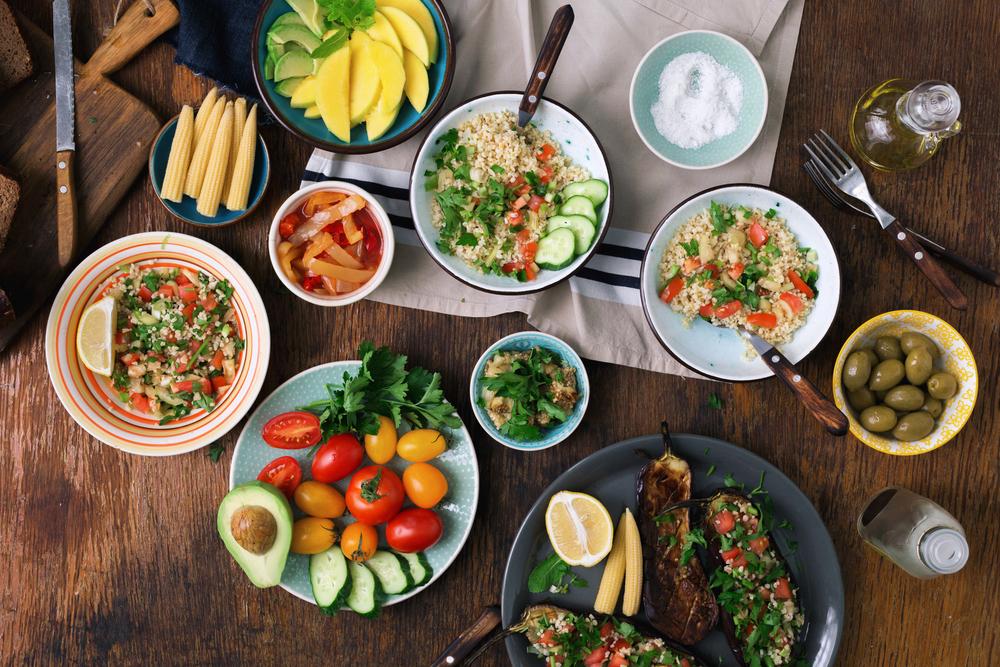 Being a vegetarian might seem at odds with also being a competitive athlete, but it’s becoming far more common, even at sports’ highest levels.
Being a vegetarian might seem at odds with also being a competitive athlete, but it’s becoming far more common, even at sports’ highest levels.
Martina Navratilova, one of the best tennis players of all-time, credits a plant-based diet as the reason she was able to win majors into her late 40s. NBA champions Glen Davis, James Jones, and John Salley are also vegetarians, as was Ironman Hall of Famer Dave Scott when he was training for his six Ironman World Championships. And five-time Wimbledon champion Venus Williams, 300-pound NFL lineman David Carter, and American champion Olympic weightlifter Kendrick Farris are not only vegetarian, but vegan.
Regardless of if your athlete participates in an endurance, strength, or even combat sport, eating a vegetarian diet and still performing to their potential can be done. Figuring out what exactly to feed a plant-based athlete isn’t always easy in the beginning, but following these tips will help them cover all their nutritional bases so they can then cross them on the field.
Tip #1: Get Enough Protein
The macronutrient vegetarians need to deliberately seek out most is protein. While plant and vegetable proteins repair muscle the same way animal proteins can, the American Dietetic Association (ADA) recommends vegetarian athletes increase their protein intake 10% to help account for plant proteins that don’t get fully digested by the body. For endurance athletes, this makes the daily protein recommendation 0.55-0.64g per pound of bodyweight and 0.73-0.77g per pound of bodyweight for more strength-based athletes.
Vegetarian athletes can account for this inherent deficit by consuming beans, nuts, seeds, whole grains, and lentils. For athletes that are ovo-lacto vegetarians (meaning they still eat some non-meat animal products), eggs and dairy are abundant sources of protein. Shakes can also be an easy and tasty way to supplement the protein normally consumed through meat. A shake recipe almost any athlete will enjoy involves blending ice, frozen fruit, chia seeds, peanut or nut butter, and protein powder with milk, coconut milk, or water.
Tip #2: Diversify the Diet
For new vegetarians, it can be easy to find a few foods that ‘work’ then become overly-reliant on them. While convenient, eating the same handful of meals can lead to deficiencies in certain vitamins and minerals. These deficiencies can be harmful to an athlete’s health and their athletic performance, causing fatigue, poor bone density, and the inability to properly repair and strengthen muscle.
The simplest way to make up for the lack of zinc, magnesium, and other micronutrients the modern diet leaves even many non-vegetarians deficient in is to ‘eat the rainbow.’ Simply, this just means to eat a wide variety of fruits and vegetables and avoid sticking to the same week in and week out. Perhaps more than any other micronutrient, vegetarians should take particular care to eat food containing Vitamin B12, which is not found in plants but can be taken in by eating B12-fortified foods such as cereals, soy milk, vegetable stock, and eggs and dairy products if your athlete is an ovo-lacto vegetarian.
Tip #3: Estimate What They’re Eating
Except for maybe 1% of the most-devoted athletes, the average teen doesn’t have the dedication to count calories, macronutrients, or plan and record their meals. But even just getting a rough estimate of their protein, fat, carbohydrate, and calorie intake while also keeping an eye on their mood, energy level, weight, and athletic performance can give a good estimate as to which areas their diet is sufficient and deficient.
Since most teens are on routine schedules and many of their meals are either prepared or eaten at home, parents themselves can log what their athletes are eating (asking when needed to fill in the gaps), then determine macronutrient and calorie counts on a site or app like MyFitnessPal or Cronometer. Logging these daily counts and simply asking your athlete how they feel for even just two to three weeks can go a long way in figuring out how to make small adjustments to a veggie athlete’s diet and help them feel and perform their best.
Tip #4: Be Mindful of The GI Index
It’s important to remember that not all vegetarian foods are created equal. Many of the foods most readily available to vegetarians also rank high on the glycemic index, a scale measuring how much influence carb-heavy foods have on the body’s blood sugar.
High GI foods are better immediately following an endurance workout as they are quickly absorbed by the body. At any other time, however, these foods spike the body’s blood sugar and promote hunger as well as fat storage. Conversely, low GI foods are digested more slowly. This leads to feeling full longer and less unwanted weight gain.
For quick reference, here is a table showing the glycemic load[1] for several common vegetarian foods. A load of 10 or below is considered low, while anything 20 or above is considered high and should be eaten sparingly.
| Food | Glycemic Load (Serving Size) |
| Hummus | 0 (30g) |
| Peanuts | 1 (50g) |
| Carrot | 4 (80g) |
| Apple | 5 (120g) |
| Black beans | 7 (150g) |
| Whole wheat bread | 9 (30g) |
| White wheat flour bread | 11 (30g) |
| Oatmeal | 13 (250g) |
| Brown rice, steamed | 16 (150g) |
| Spaghetti, whole grain | 17 (180g) |
| Instant Oatmeal | 21 (30g) |
| Sweet Potato | 22 (150g) |
| Bagel (white) | 25 (70g) |
| Raisins | 28 (60g) |
| White rice, boiled | 29 (150g) |
| Russet Potato | 33 (150g) |
The glycemic indices and loads for more foods can be found at Health.Harvard.edu
Tip #5: Making A Calculated Transition
If your athlete is merely just interested in the idea of vegetarianism or wants to try it out and see how it affects their athletic performance, it might be easier for everyone involved to make it a gradual transition as opposed to a wholesale, overnight change.
If you and your athlete eat meat every day, a first step could be to try and incorporate ‘meatless Mondays’ (or any other day) as a first step in experimenting with recipes and the new logistical challenges that come with making the switch. From there, veggie-only days could be expanded to two days a week and so on, until a groove is hit where it becomes easier to not have to think about preparing meatless dishes.
A Sample Meal Plan for Vegetarian Athletes
Keeping in mind the above, a daily mean plan for a vegetarian teen participating in a cardiovascular-demanding sport could look like some combination of the following:
Breakfast
- Oats with yogurt and fruit
- Smoothie with frozen fruit, chia seeds, peanut or nut butter, protein powder, coconut milk
- Potato and broccoli frittata (ovo-lacto)
Lunch or Dinner
- Rice or pasta with tofu, vegetables, and sauce
- Quinoa bowl with lentils, beans, salsa
- Cauliflower and chickpea curry, side salad, and baked sweet potato
- Black bean burgers with grilled peppers and hummus
- Margherita pizza with stuffed Portobello mushrooms
- Baked penne pasta with roasted vegetables
Snacks/Anytime
- Fruits
- Nuts
- Hummus/lentil/chickpea/black bean dip
- Dark chocolate
- Coconut ice cream
- Fruit ‘crumble’ bars
- Popcorn
Like with anything diet-related, figuring out what’s best for your vegetarian athlete is going to be a matter of trial and error. Ultimately, it will be steady small changes that lead to the big ones they are looking for from a diet change.
Sources:
https://lifehacker.com/what-it-means-to-eat-the-rainbow-1594799068
https://www.healthline.com/health/vitamin-b12-foods-for-vegetarians-risks-and-complications
https://www.healthline.com/nutrition/7-common-nutrient-deficiencies
https://en.wikipedia.org/wiki/Glycemic_index
http://www.ideafit.com/fitness-library/training-tips-for-vegetarian-athletes
https://foodtolive.com/healthy-blog/diet-training-tips-vegetarian-athletes/
https://www.reddit.com/r/Fitness
http://www.stack.com/a/vegetarian-athlete-kate-ziegler
http://www.anitabean.co.uk/nutrition-tips-vegetarian-athletes-2/
http://www.nomeatathlete.com/vegetarian-recipes-for-athletes/
https://www.shape.com/healthy-eating/healthy-recipes/13-easy-and-healthy-frittata-recipes
[1] From health.harvard.edu: The glycemic load is determined by multiplying the grams of a carbohydrate in a serving by the glycemic index, then dividing by 100.



